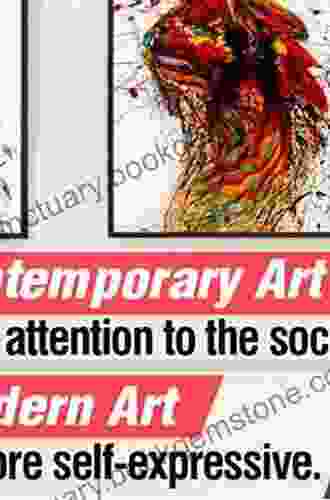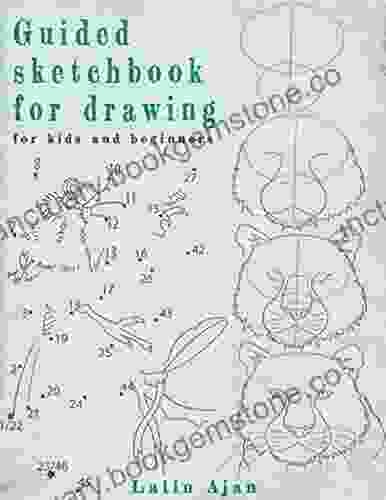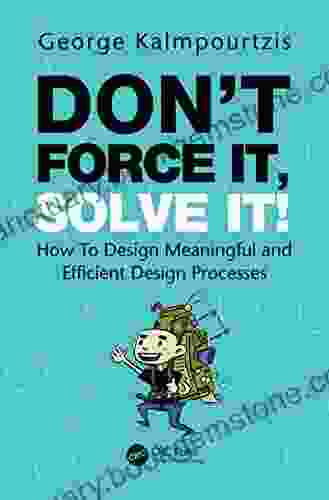How To Design Meaningful And Efficient Design Processes

Design is a complex and challenging field, but it is also incredibly rewarding. When done well, design can make a real difference in the world. It can create products and services that are both useful and beautiful, and it can help to improve the lives of people.
5 out of 5
| Language | : | English |
| File size | : | 36752 KB |
| Text-to-Speech | : | Enabled |
| Screen Reader | : | Supported |
| Enhanced typesetting | : | Enabled |
| Print length | : | 265 pages |
But in order to create truly meaningful and efficient design, it is important to have a well-defined design process. A design process is a step-by-step guide that helps you to translate your ideas into reality. It provides a framework for making decisions, and it helps to ensure that all of the necessary steps are taken to create a successful product or service.
There are many different design processes out there, but they all share some common elements. The following are the key steps in any design process:
- Research: The first step in any design process is to conduct research. This research will help you to understand the problem that you are trying to solve, and it will provide you with the information that you need to make informed decisions.
- Ideation: Once you have completed your research, it is time to start generating ideas. This is the stage where you will come up with new and innovative solutions to the problem that you are trying to solve.
- Prototyping: Once you have a few ideas, it is time to start prototyping them. Prototypes are physical or digital representations of your ideas, and they will allow you to test them out in the real world.
- Testing: Once you have created a prototype, it is important to test it with users. This will help you to identify any problems with your design, and it will give you the opportunity to make improvements.
- Implementation: Once you have tested your prototype and made any necessary improvements, it is time to implement your design. This is the stage where you will create the final product or service.
The design process is not always linear. You may need to iterate through the steps several times before you are satisfied with the final product. However, by following a well-defined process, you can increase your chances of success.
Tips for Designing Meaningful and Efficient Design Processes
Here are a few tips to help you design meaningful and efficient design processes:
- Start with a clear goal: Before you start any design process, it is important to have a clear goal in mind. What do you want to achieve with your design? Once you know your goal, you can start to develop a process that will help you to achieve it.
- Involve stakeholders early on: It is important to involve stakeholders in the design process from the very beginning. This will help to ensure that everyone is on the same page and that the design meets the needs of all stakeholders.
- Use a collaborative approach: Design is a team sport. It is important to involve other people in the design process, such as engineers, marketers, and users. This will help to ensure that the design is well-rounded and that it meets the needs of all stakeholders.
- Be flexible: The design process is not always linear. You may need to iterate through the steps several times before you are satisfied with the final product. Be prepared to adjust your process as needed.
- Document your process: It is important to document your design process. This will help you to communicate your process to others, and it will also help you to improve your process over time.
By following these tips, you can design meaningful and efficient design processes that will help you to create successful products and services.
5 out of 5
| Language | : | English |
| File size | : | 36752 KB |
| Text-to-Speech | : | Enabled |
| Screen Reader | : | Supported |
| Enhanced typesetting | : | Enabled |
| Print length | : | 265 pages |
Do you want to contribute by writing guest posts on this blog?
Please contact us and send us a resume of previous articles that you have written.
 Best Book
Best Book Page Flip
Page Flip Bookshelf
Bookshelf Literary loom
Literary loom Chapter
Chapter Bookish
Bookish PageTurner
PageTurner Bibliophile
Bibliophile Story
Story Inkwell
Inkwell Bookworm
Bookworm Labyrinth
Labyrinth Plot Twist
Plot Twist Prose
Prose Paperback
Paperback Storyteller
Storyteller Sanctuary
Sanctuary Fiction
Fiction Reading
Reading Chronicle
Chronicle Read
Read Nicole Grotepas
Nicole Grotepas Sarah Ferguson
Sarah Ferguson Andrew Dickos
Andrew Dickos Dawnie Walton
Dawnie Walton Jonathan Rauch
Jonathan Rauch Ruskin Bond
Ruskin Bond Jessica Alba
Jessica Alba Kevin Grange
Kevin Grange Patricia Preciado Martin
Patricia Preciado Martin Ted Kerasote
Ted Kerasote Scott Bartlett
Scott Bartlett Melissa Riddell
Melissa Riddell Diana Gabaldon
Diana Gabaldon David Loud
David Loud E B Sledge
E B Sledge Andrew Vietze
Andrew Vietze Anna Mocikat
Anna Mocikat Kent Babb
Kent Babb Phoenix Collins
Phoenix Collins Andrew Grant
Andrew Grant Danielle Geller
Danielle Geller Andrea Jackson
Andrea Jackson Charla Krupp
Charla Krupp Stephen Kurkjian
Stephen Kurkjian E M Foner
E M Foner John M Olsen
John M Olsen Cissy Houston
Cissy Houston Angelo Colorni
Angelo Colorni T J Demos
T J Demos Duncan Heath
Duncan Heath Jack Lucas
Jack Lucas Andrew Graham Dixon
Andrew Graham Dixon Andreas Deja
Andreas Deja Liao Yiwu
Liao Yiwu Natasha Solomons
Natasha Solomons Jamila Jasper
Jamila Jasper Paul Reps
Paul Reps Angus Donald
Angus Donald Sam Fury
Sam Fury Michael Tubbs
Michael Tubbs Anna Todd
Anna Todd David Nees
David Nees Angela Hunt
Angela Hunt Angelique V Nixon
Angelique V Nixon Andrew Bostock
Andrew Bostock Andrew Marble
Andrew Marble James Martin
James Martin Kianna Alexander
Kianna Alexander Angela Wolf
Angela Wolf Ryan White
Ryan White Condoleezza Rice
Condoleezza Rice Jean Ann Shirey
Jean Ann Shirey Nancy Princenthal
Nancy Princenthal Jeff Fletcher
Jeff Fletcher Octavio Solis
Octavio Solis Mary Robinette Kowal
Mary Robinette Kowal Michele Sullivan
Michele Sullivan Harriet Welty Rochefort
Harriet Welty Rochefort Anne Pannecke
Anne Pannecke Anna Stephens
Anna Stephens Michelle Lee
Michelle Lee Edward Bellamy
Edward Bellamy Christopher Greyson
Christopher Greyson Katrina Mcpherson
Katrina Mcpherson Emily Bingham
Emily Bingham Jack Porter
Jack Porter Leslie Redhead
Leslie Redhead Emma Newman
Emma Newman Jill Braden
Jill Braden Andrei Besedin
Andrei Besedin Ys Publishing
Ys Publishing Jeb Rosebrook
Jeb Rosebrook Anna Salton Eisen
Anna Salton Eisen Barbara Sillery
Barbara Sillery Angela Marie Moulton
Angela Marie Moulton Fred Saberhagen
Fred Saberhagen Waldemar Bogoras
Waldemar Bogoras Wendy Jelbert
Wendy Jelbert Lyonel Feininger
Lyonel Feininger Tiffany L Warren
Tiffany L Warren Jason Sommer
Jason Sommer Margaret Wander Bonanno
Margaret Wander Bonanno Anna Cavallo
Anna Cavallo Kent Wong
Kent Wong Julie Klassen
Julie Klassen Andy Southall
Andy Southall Josh Hanagarne
Josh Hanagarne Taylor Michaels
Taylor Michaels Christopher S Wood
Christopher S Wood Donald Preziosi
Donald Preziosi Anna Pasternak
Anna Pasternak Andrea Pflaumer
Andrea Pflaumer Rhonda Mcknight
Rhonda Mcknight Monica Moody
Monica Moody Edward Seidensticker
Edward Seidensticker Godfrey Baldacchino
Godfrey Baldacchino Lisa Dickey
Lisa Dickey Tina Brown
Tina Brown Eric Seale
Eric Seale Ann Marks
Ann Marks James T Deshields
James T Deshields Andrew Moor
Andrew Moor Joseph E Persico
Joseph E Persico Anita Brookner
Anita Brookner Sara Funduk
Sara Funduk Jason Kramar
Jason Kramar Susan Ross
Susan Ross Bathroom Readers Institute
Bathroom Readers Institute Farha Ghannam
Farha Ghannam Paul Robert Walker
Paul Robert Walker Dominique Auzias
Dominique Auzias Val Wake
Val Wake Alex Tannen
Alex Tannen J D Robb
J D Robb Anne C Heller
Anne C Heller Tim Slessor
Tim Slessor Jenny Schwartz
Jenny Schwartz Judy Omar
Judy Omar Jane Dunnewold
Jane Dunnewold Anna Hackett
Anna Hackett Frederic Lombardi
Frederic Lombardi Andrew Hund
Andrew Hund Crystal Daniels
Crystal Daniels Ann C Hall
Ann C Hall Anne Billson
Anne Billson David Blatner
David Blatner Kristina Liu
Kristina Liu Andrew Johnson
Andrew Johnson Regine Abel
Regine Abel Andy Keen
Andy Keen Martin Cruz Smith
Martin Cruz Smith Emily Louise Howard
Emily Louise Howard Fawzia Koofi
Fawzia Koofi Henry Van Dyke
Henry Van Dyke Gary Faigin
Gary Faigin Anita Nipane
Anita Nipane Holly Moss
Holly Moss Angelina Jolie
Angelina Jolie Barbara Lasalle
Barbara Lasalle Anna Bartlett
Anna Bartlett Andy Herbach
Andy Herbach Disamis Arcia Munoz
Disamis Arcia Munoz Quincy Jones
Quincy Jones Ann C Smith
Ann C Smith Nicholas Meyer
Nicholas Meyer Yan Lianke
Yan Lianke David Mamet
David Mamet Gabrielle Moss
Gabrielle Moss Ann Aguirre
Ann Aguirre Ronnie Smith
Ronnie Smith Angie Grace
Angie Grace Kate Frost
Kate Frost Elizabeth L Block
Elizabeth L Block Yossi Maimon
Yossi Maimon John Charles Bennett
John Charles Bennett Legacy Russell
Legacy Russell Anna Badkhen
Anna Badkhen Terry Brooks
Terry Brooks Andrea Lee
Andrea Lee Andrew Dewar
Andrew Dewar Anna Qu
Anna Qu George Kalmpourtzis
George Kalmpourtzis Dina Nayeri
Dina Nayeri Anika Fajardo
Anika Fajardo Michael Punke
Michael Punke Elaine Welteroth
Elaine Welteroth Theodore Annemann
Theodore Annemann J Bright
J Bright Nicholas Roerich
Nicholas Roerich Mark Horrell
Mark Horrell Michiyo
Michiyo Gavin Ambrose
Gavin Ambrose W H Bartlett
W H Bartlett Heather Galler
Heather Galler Michael Howard
Michael Howard Charles Reid
Charles Reid Andrew Cunningham
Andrew Cunningham Rickie Lee Jones
Rickie Lee Jones Andrew M Dobell
Andrew M Dobell Angharad Lewis
Angharad Lewis Patrick Smithwick
Patrick Smithwick Andrew Moriarty
Andrew Moriarty Jeffrey Chipps Smith
Jeffrey Chipps Smith Bill Fawcett
Bill Fawcett Angus Johnstone
Angus Johnstone Andrew Darby
Andrew Darby Walter Foster
Walter Foster Anna Malaika Tubbs
Anna Malaika Tubbs Erwin Panofsky
Erwin Panofsky Charles Bukowski
Charles Bukowski Andrew Carroll
Andrew Carroll Andy Mckell
Andy Mckell Marc Shapiro
Marc Shapiro Anita Heiss
Anita Heiss Flavio Ferrari Zumbini
Flavio Ferrari Zumbini Erin Lewis Fitzgerald
Erin Lewis Fitzgerald Christine Leteux
Christine Leteux Erika Warmbrunn
Erika Warmbrunn Andrew Porwancher
Andrew Porwancher Bernie Marcus
Bernie Marcus Royal Horticultural Society
Royal Horticultural Society Anjali Enjeti
Anjali Enjeti Angus Roxburgh
Angus Roxburgh Lance Esplund
Lance Esplund David J Dennis Jr
David J Dennis Jr Fern Michaels
Fern Michaels Tetiana Elert
Tetiana Elert Shel Perkins
Shel Perkins Andrea Fazzari
Andrea Fazzari Angelico Chavez
Angelico Chavez Nintendo
Nintendo Sergio Bizzio
Sergio Bizzio Frederick Stirton Weaver
Frederick Stirton Weaver Anjan Chatterjee
Anjan Chatterjee Annalee Newitz
Annalee Newitz Andrew Tunstall
Andrew Tunstall G J Younghusband
G J Younghusband Lynda Vaughn
Lynda Vaughn D C Palter
D C Palter Anna Koliadych
Anna Koliadych Andrew Parker
Andrew Parker C Y Croc
C Y Croc Liz Neves
Liz Neves Stephanie Laurens
Stephanie Laurens Tony Wheeler
Tony Wheeler Dita Von Teese
Dita Von Teese Royd Tolkien
Royd Tolkien Dominic Roskrow
Dominic Roskrow Anna Jean Mayhew
Anna Jean Mayhew John Driver
John Driver Hamish Bowles
Hamish Bowles Marie Force
Marie Force Graeme Davis
Graeme Davis Ann Budd
Ann Budd Bruce Feiler
Bruce Feiler Simon Schama
Simon Schama Ann Beaglehole
Ann Beaglehole Robert Alan Brookey
Robert Alan Brookey Zane Lamprey
Zane Lamprey Robert Ludlum
Robert Ludlum Anette Fischer
Anette Fischer L T Ryan
L T Ryan Sherry Ginn
Sherry Ginn Kien Nguyen
Kien Nguyen Isabel Allende
Isabel Allende Cornel West
Cornel West Anna Goldenberg
Anna Goldenberg Anna Deavere Smith
Anna Deavere Smith James Canton
James Canton Luis Carlos Montalvan
Luis Carlos Montalvan Shannon Leone Fowler
Shannon Leone Fowler R G Richardson
R G Richardson Andrew Bowden
Andrew Bowden Anna Starmer
Anna Starmer Andrew Mayne
Andrew Mayne John Gilstrap
John Gilstrap Angie Martinez
Angie Martinez Carlos Del Amor
Carlos Del Amor Laura Lee
Laura Lee L J Martin
L J Martin Anna Paola Sanna
Anna Paola Sanna Julie Ann Walker
Julie Ann Walker David Hampshire
David Hampshire Caroline James
Caroline James Frank Kennedy
Frank Kennedy Fred Botting
Fred Botting Rob Craig
Rob Craig Angel Williams
Angel Williams Ani Trime
Ani Trime Andy Warhol
Andy Warhol B Love
B Love Harry Houdini
Harry Houdini Diane Esguerra
Diane Esguerra Kliph Nesteroff
Kliph Nesteroff Chris Weyers
Chris Weyers Haley Hoover
Haley Hoover Annabel Chase
Annabel Chase Zachary Lamothe
Zachary Lamothe Anna Nadler
Anna Nadler Anna M Mazur
Anna M Mazur Padma Lakshmi
Padma Lakshmi Ann Hoffman
Ann Hoffman Ernest Hemingway
Ernest Hemingway Jack Gernsheimer
Jack Gernsheimer Michael Asher
Michael Asher Joshua Rivkin
Joshua Rivkin Emiko Davies
Emiko Davies Andrew Juniper
Andrew Juniper Mari K Eder
Mari K Eder Andreas Marks
Andreas Marks John C Cranham Dds
John C Cranham Dds Jeremy Mercer
Jeremy Mercer William J Lederer
William J Lederer Kitty Gorrell
Kitty Gorrell John Patrick Bray
John Patrick Bray Roman Frister
Roman Frister Robin Koontz
Robin Koontz Mike Epps
Mike Epps Angus M Gunn
Angus M Gunn Camil Flores
Camil Flores Andrea Erickson
Andrea Erickson Jarrett Brandon Early
Jarrett Brandon Early Jocelyn Harewood
Jocelyn Harewood Andrew Vaillencourt
Andrew Vaillencourt Kat Chow
Kat Chow Shirley Anstis
Shirley Anstis Nina Willner
Nina Willner Hilary Spurling
Hilary Spurling Louise Egerton
Louise Egerton J B Rosenberg
J B Rosenberg Tom Sileo
Tom Sileo John Sugden
John Sugden Lonneke Geerlings
Lonneke Geerlings Andrew Osmond
Andrew Osmond Maggie O Farrell
Maggie O Farrell Christie Taylor
Christie Taylor Marina Benjamin
Marina Benjamin Daniella Weiss Ashkenazy
Daniella Weiss Ashkenazy Bridget Alsdorf
Bridget Alsdorf Billy Ray Belcourt
Billy Ray Belcourt J N Chaney
J N Chaney Anjelah Johnson Reyes
Anjelah Johnson Reyes Scott Baron
Scott Baron Elisa Russell
Elisa Russell Andrei Codrescu
Andrei Codrescu Anna Corba
Anna Corba Terry Newman
Terry Newman Pao Lor
Pao Lor Kathryn Wilder
Kathryn Wilder Angie Daniels
Angie Daniels Maxim Peter Griffin
Maxim Peter Griffin Juanitta Baldwin
Juanitta Baldwin Rachel Rubin Wolf
Rachel Rubin Wolf Kindle Edition
Kindle Edition Scott Thybony
Scott Thybony Manuel Huitzilli
Manuel Huitzilli Andrew Haslam
Andrew Haslam Kindle Edition With Audio Video
Kindle Edition With Audio Video Sylvia Day
Sylvia Day Clemantine Wamariya
Clemantine Wamariya Xander Black
Xander Black Stuart Campbell
Stuart Campbell Annabelle Honess Roe
Annabelle Honess Roe Laura Bradbury
Laura Bradbury Andy Davidson
Andy Davidson Denny S Bryce
Denny S Bryce Drew Kwong
Drew Kwong Ernesto Che Guevara
Ernesto Che Guevara Shawn Kelly
Shawn Kelly Marilyn Chase
Marilyn Chase Andrew Karevik
Andrew Karevik J C Cooper
J C Cooper Sylvan Barnet
Sylvan Barnet Andy Mcdermott
Andy Mcdermott Siren
Siren Sarah Herman
Sarah Herman Shellise Berry
Shellise Berry Van Lu
Van Lu Josie Iselin
Josie Iselin Dorothy Hartley
Dorothy Hartley Denys Johnson Davies
Denys Johnson Davies Darrin Duford
Darrin Duford Christina Klein
Christina Klein Ann Cleeves
Ann Cleeves Kimberly Brock
Kimberly Brock Rita Moreno
Rita Moreno William W Johnstone
William W Johnstone Charlie English
Charlie English C L Parker
C L Parker Caroline Linscott
Caroline Linscott Ann Blockley
Ann Blockley Andy Mcnab
Andy Mcnab Catherine Berry
Catherine Berry Mark Henwick
Mark Henwick Ben G Frank
Ben G Frank John F Mullins
John F Mullins Dave Clayton
Dave Clayton D C Robinson
D C Robinson Danielle Prescod
Danielle Prescod Angela D French
Angela D French Don Bluth
Don Bluth Glenn Adamson
Glenn Adamson Kristina Kozak
Kristina Kozak Stacey L Nash
Stacey L Nash Andrew Forkner
Andrew Forkner Howard Thurston
Howard Thurston Octave Uzanne
Octave Uzanne Steven Bleicher
Steven Bleicher Jane Akshar
Jane Akshar Milton Glaser
Milton Glaser Laurinda Reddig
Laurinda Reddig Anne Bogart
Anne Bogart Doris Kennedy
Doris Kennedy Andrew Sutton
Andrew Sutton Andrew Delaplaine
Andrew Delaplaine Angie Cruz
Angie Cruz Christopher Fowler
Christopher Fowler Ray Scippa
Ray Scippa Andrew Mcmahon
Andrew Mcmahon Jake Sherman
Jake Sherman Andrew Wilson
Andrew Wilson Carole Jackson
Carole Jackson Mia Sheridan
Mia Sheridan Gary Spetz
Gary Spetz Guy Stern
Guy Stern Anna Kirtlan
Anna Kirtlan Betty Arnett
Betty Arnett Anna Sherman
Anna Sherman Brian Shea
Brian Shea Cion Lee
Cion Lee Larry Silverberg
Larry Silverberg Lakisha Johnson
Lakisha Johnson Ed Duncan
Ed Duncan Andrew Meier
Andrew Meier Andrea Pomerantz Lustig
Andrea Pomerantz Lustig Magic Guidebooks
Magic Guidebooks Jane Hamilton
Jane Hamilton Annie Dillard
Annie Dillard Robin Sloan
Robin Sloan Angela Gaughan
Angela Gaughan Raymond F Jones
Raymond F Jones
Light bulbAdvertise smarter! Our strategic ad space ensures maximum exposure. Reserve your spot today!
 Leslie CarterFollow ·4.7k
Leslie CarterFollow ·4.7k Gary CoxFollow ·10.2k
Gary CoxFollow ·10.2k Ed CooperFollow ·2.4k
Ed CooperFollow ·2.4k Edgar Allan PoeFollow ·8k
Edgar Allan PoeFollow ·8k Howard BlairFollow ·14.3k
Howard BlairFollow ·14.3k Andy ColeFollow ·5.1k
Andy ColeFollow ·5.1k Alex ReedFollow ·14.1k
Alex ReedFollow ·14.1k Sam CarterFollow ·17.2k
Sam CarterFollow ·17.2k

 Ethan Mitchell
Ethan MitchellWe Are Here To Hurt Each Other: A Deep Dive into the...
Yes, I can help you with that. Here is an...

 Xavier Bell
Xavier BellHannah Arendt: A Life in Dark Times
Hannah Arendt was a...

 Donovan Carter
Donovan CarterThe Art of Looking: A Comprehensive Exploration of Visual...
: The Power of...

 Terence Nelson
Terence NelsonUnveiling the Secrets of Moscow's Red Square: A Journey...
In the heart of Moscow,...

 Cruz Simmons
Cruz SimmonsDrawing Workbook for Kids and Beginners: An Enchanting...
: Unveiling the Magic of Drawing Drawing, an...
5 out of 5
| Language | : | English |
| File size | : | 36752 KB |
| Text-to-Speech | : | Enabled |
| Screen Reader | : | Supported |
| Enhanced typesetting | : | Enabled |
| Print length | : | 265 pages |














